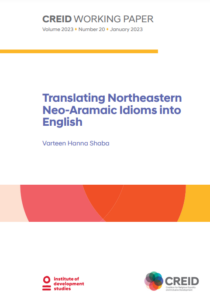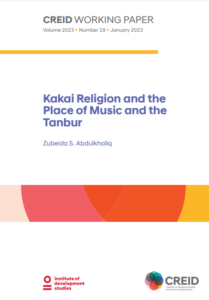As part of the IDS-led Coalition for Religious Equality and Inclusive Development (CREID), we are working with religious minority communities in Iraq and Syria to pluralise heritage voices by undertaking oral histories that document the heritage that they deem valuable. As part of an upcoming series of blogs we will be showcasing some of these diverse aspects of people’s heritage.

Yazidi at Lalish temple, northern Iraq. Credit: S. Shahab
When we think of heritage, our minds might typically conjure images of ancient archaeological sites such as Stonehenge or artefacts in museums to be admired from behind glass barriers. These forms of heritage are tangible heritage – built sites and physical objects that have material form and can be seen, touched and held.
However, it’s all too easy to forget that these places were once part of the ritual lives and practices of communities, or that the artefacts on display were also belongings to be used by their owners – such as the jewellery worn during religious ceremonies.
When heritage is deliberately destroyed by groups like the Taliban or Daesh it is most often tangible sites (such as the Buddhas in Bamiyan or Tetrapylon in Palmyra) that garner media and world attention. However, these sites are valuable for more than their archaeological or historical import. This is because tangible heritage comes about through intangible heritage practices: festivals, music, songs, rituals – some of which have died and disappeared over time, others of which persist to this day. With their destruction can come a much wider but more invisible destruction – that of living communities and the shared practices that bind them together.
Intangible heritage practices can be a matter of survival for many communities around the world
For many communities around the world, these intangible practices are what define them and what keeps them together. This is especially important when communities are threatened, for example, due to persecution or who have been displaced from their homes. At these times heritage can facilitate connection despite physical distance via shared experiences and memories. In this way heritage extends beyond territorial fixity and can be encountered through stories and images.
In the culturally rich and diverse disputed territories of northern Iraq, home to some of the world’s oldest religions and communities, heritage has become a matter of survival against- firstly the Baathist regime of Saddam Hussain but more recently and more destructively, Daesh. These groups’ intent on homogenisation is one way to insidiously consolidate their grip on power long after the guns have been silenced.
While it may be possible to rebuild or rehabilitate some of the tangible heritage sites that have been destroyed and to continue some intangible practices outside of these places, capturing the memories associated with the places, festivals, foods and rites of dispersed communities can be another way of preserving them, enabling new forms of encounters across spaces and generations. This is vital in helping to maintain the identities and social bonds that ensure their continued survival.
By giving space over the next few weeks to some of the voices and heritage of communities from in and around Mosul, we celebrate and recognise the diversity of a region which has been home to numerous religious communities in working to preserve this rich heritage and the groups to whom it belongs.


